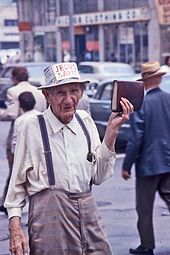Open-air preaching
 From Wikipedia - Reading time: 6 min
From Wikipedia - Reading time: 6 min

Open-air preaching, street preaching, or public preaching is the act of evangelizing a religious faith in public places. It is an ancient method of proselytizing a religious or social message and has been used by many cultures and religious traditions, but today it is usually associated with evangelical Protestant Christianity. Supporters of this approach note that both Jesus[1] and many of the Old Testament prophets often preached about God in public places.[2] It is one of the oldest approaches to evangelism.[1]
In the Bible
[edit]
One of the earliest open-air preachers of Christianity, according to the gospels, was Jesus Christ, whose first specifically recorded sermon was the Sermon on the Mount,[1][2] which took place on a mountainside in the open air.[3] In the Gospel of Luke (Luke 6:17–49), it was recorded that Jesus also gave an open-air sermon known as the Sermon on the Plain.[2] In Mark 16:15, street preaching is seen as a commandment from Jesus as a way to warn people about sins and their consequences. This is supported by Isaiah 58:1 and Jeremiah 2:2.[4][5]
After Jesus' death and resurrection, many of his apostles and followers started street preaching the gospel in the Temple of Jerusalem and in other open spaces.[1][2]
The Christian Apologetics and Research Ministry lists the "many examples of street preaching in the Bible" as including Noah, Solomon, Ezra, Jeremiah, Jonah, John the Baptist, Jesus Christ, Peter, Paul, Phillip and Apollos.[6]
Middle Ages and Reformation
[edit]Open-air preaching was used by mendicant orders in the High Middle Ages to initiate a renewal of religious fervor among Catholics, and to fight heretical movements such as Catharism in southern France. Later, during the Protestant Reformation, it was often employed by Protestants throughout Europe[7] who could not always preach inside churches, which were mostly Catholic.[8] Open-air preaching in Europe continued during the rise of Puritanism and other Protestant movements.[2] It was often used in Pastoral environments as well as in cities, the former sometimes due to a desire to avoid the authorities,[9] and the latter because, for one reason, it could reach eccentric people living in cities who would not otherwise hear the gospel.[10]
Evangelical Revivals
[edit]
Early Methodist preachers John Wesley and George Whitefield preached in the open air, which allowed them to attract crowds larger than most buildings could accommodate.[12] On one occasion when Wesley was forbidden to preach inside the church in his hometown, Epworth, he used his father's tombstone in the churchyard as a pulpit.[13] Whitefield stated: "I believe I never was more acceptable to my Master than when I was standing to teach those hearers in the open fields ... I now preach to ten times more people than I should, if had been confined to the churches."[verify]
Open-air preachers throughout history have often noted that preaching to large crowds often causes preachers to be abused in certain ways, even having objects thrown at them such as rotting vegetables or unsanitary liquids of many varieties.[14] It was said that one of the regular practices of American evangelist Dwight L. Moody in the late 1860s "was to exhort the passersby in the evenings from the steps of the court house. Often these impromptu gatherings drew as many hecklers as supporters."[15]
In the late 19th century and early-to-mid 20th century many famous open-air preachers in the United States began to preach, such as Billy Graham and Billy Sunday.[16] Graham in particular used a combination of open-air preaching and the recent advent of televangelism to broadcast his sermons, which often took place in large venues such as stadiums, to large portions of the world and millions of Americans.[17]

Charles Spurgeon, the famous open-air Baptist preacher of England, believed that open-air preaching was instrumental in getting people to hear the gospel who might otherwise never hear it,[2][18] and today, open-air preachers such as Ray Comfort believe that it reaches many more people at once than other approaches to evangelism do.[19]
Notable open-air preachers
[edit]Historic
[edit]Active in the 21st century
[edit]- Micah Armstrong
- Jed Smock
- Ray Comfort
- Samuel Chambers (State Street Preacher)
- Reinhard Bonnke
- David Grisham
References
[edit]- ^ a b c d Spurgeon, p. 234
- ^ a b c d e f http://www.biblebelievers.com/StreetPreaching2.html Archived 2007-04-10 at the Wayback Machine "OPEN-AIR PREACHING, A SKETCH OF ITS HISTORY AND REMARKS THEREON", Charles H. Spurgeon.
- ^ "Bible Gateway passage: Matthew 5:1 - New International Version". Bible Gateway.
- ^ "Beginner's Discipleship Class 13c : Why Street Preaching is Biblical". Real Bible Believers. 29 March 2020.
- ^ "What is Biblical Street Evangelism? - Right Biblical Street Evangelism". www.conformingtojesus.com.
- ^ Tony Miano/Matt Slick, "Are There Examples of Street Preaching in the Bible?" Christian Apologetics and Research Ministry http://www.carm.org/biblical-examples-street-preaching
- ^ Spurgeon, p. 235
- ^ Spurgeon, p 236
- ^ Spurgeon, p. 241
- ^ Spurgeon, p. 257
- ^ Gibson, James. "Wesleyan Heritage Series: Entire Sanctification". South Georgia Confessing Association. Archived from the original on 29 May 2018. Retrieved 30 May 2018.
- ^ The first Great Awakening Archived 2010-01-25 at the Wayback Machine, Tony Cauchi, Jamaica Gleaner
- ^ JOHN WESLEY.; G. Holden Pike's History of the Great Methodist and His Associates, New York Times
- ^ Spurgeon, Pg. 250
- ^ "A History Of Street Preaching". Soulwinning.info. Archived from the original on 2012-08-22. Retrieved 2013-02-15.
- ^ "Billy Sunday Salty evangelist". ChristianityToday.com. Archived from the original on 2007-02-15.
- ^ "Lee, R. "The History Guy: The Reverend Billy Graham"". Archived from the original on 2007-01-13. Retrieved 2007-02-04.
- ^ Spurgeon, p. 255
- ^ "The Evidence Bible", Ray Comfort, Bridge-Logos Publishers, 2003, p. 1183
Bibliography
[edit]- Charles Haddon Spurgeon, "Lectures to My Students", Zondervan publishing house, 1977, Eighth printing, ISBN 0-310-32910-8
 KSF
KSF